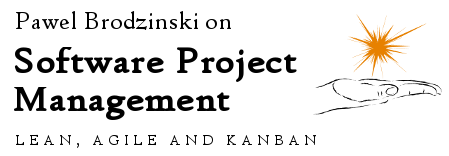We have limits on our Kanban board. This isn’t really a news. Sometimes we abuse them. Since Kanban doesn’t force you to stick to the limits always-and-by-all-means it shouldn’t surprise you much either. However the interesting thing is when, why, how and how often we do it.
I think I should start with stating that our limits are rather loose. It is technically possible to have as many as 15 MMFs in progress across the board. It never happened and it won’t ever happen, but still it is technically feasible. That’s crazy huge workload for 5-person team.
But we happen to have limits like that and it’s not without a reason. If you recall our pseudo-iterations triggered by VCS issues you know we ship our software in packages of few (typically 2 or 3, sometimes 4) features. This means we sometimes move a group of 4 features across the board. For example it happens after deployment when we move features from testing complete to live stage. OK, enough of introduction about our limits.
When do we abuse limits?
It sometimes happens we change content of our deployment package on the fly. For example we have a package of 4 features in testing (either ongoing or completed) and then our crazy product owner (aka me) comes with an idea to add another tiny but super-important and super-urgent feature. Of course we could wait till another pseudo-iteration is deployed but sometimes it just makes more sense to add it to the old package instead of waiting another 13 days for another deployment package.
We also had a painful MMF blocked for long weeks by our subcontractor. This practically reduced our limit in development by 1 for a longer time. It happened once that we decided to break this reduced limit acknowledging the fact we can do nothing more about blocked feature.
Why do we abuse limits?
Two words: common sense. If it is more reasonable to break the limit than to adjust whole work to our board we don’t try to perform some artificial actions just to be compliant with the process.
We aren’t here for the board. The board is here for us.
How do we abuse limits?
First we all discuss the decision. Breaking the limit shouldn’t be treated as a normal thing. It is an extraordinary situation. So we collectively decide whether in this very situation breaking the limit is a better solution or we should rather stick to our constraints.
This serves two purposes: one, we make this decision very consciously and two, we stress that it isn’t a typical and easy-to-accept situation.
It happened once when I found the board with a broken limit with no discussion whatsoever about the fact. I fired two third of the team and burned whole office… Well, maybe not really, but man, I wasn’t happy. I wasn’t happy at all.
How often do we abuse limits?
This is the question you were waiting for, weren’t you? Pretty rarely I’d say – thrice a year. Well, describing it as an average result is a bit of abuse itself since it was our first year with Kanban. But you can see this is an extraordinary situation.
To summarize, limits on our Kanban board aren’t a sacred cow. We break them if it does make sense and we decide it is a better solution than sticking to them at all cost. On the other hand we try to make breaking the limit an uncomfortable situation (you know, all this discussion, talking with each other… yikes) so we aren’t tempted to do this very often.
So far it works pretty well.
Read the rest of the Kanban Story.


 Subscribe RSS feed
Subscribe RSS feed Follow on Twitter
Follow on Twitter Subscribe by email
Subscribe by email



0 comments… add one